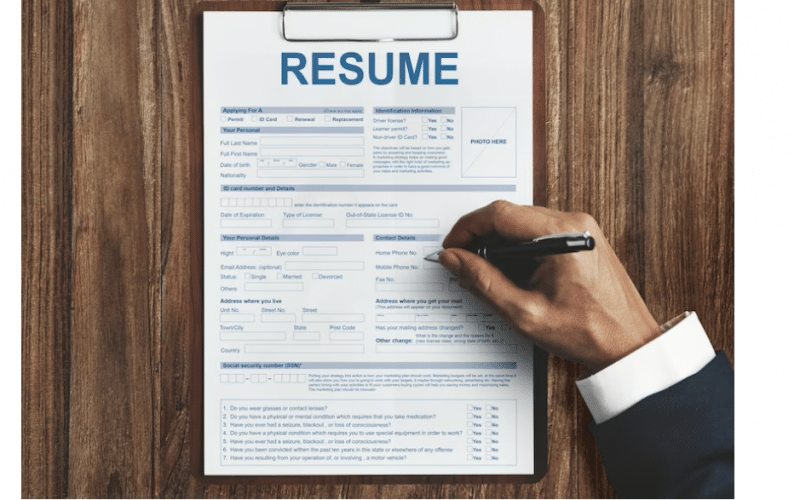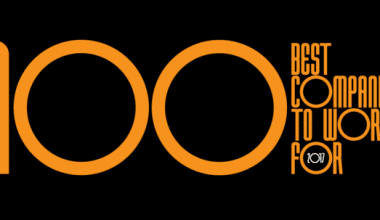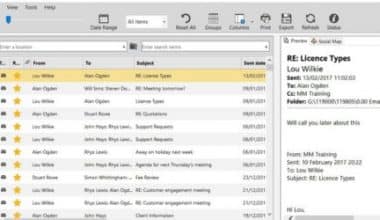A strong resume is crucial for job seekers, as it sets the tone for responses from other companies. A weak resume can result in weeks or even months of waiting for a response. This guide teaches you how to build a resume that leads to HR managers inviting you to interviews.
What Is A Resume?
A resume is a document that a candidate for a job writes to list their qualifications for the role. Additionally, a cover letter, which is usually included with a resume, is used to highlight the most important facts on the resume and express interest in a particular position or business.
A resume should only be one or two pages long, according to American job coaches. Traditionally, job applicants in Britain are required to submit a CV, which is a slightly more detailed document (curriculum vitae).
Note that:
- These days, resumes are usually submitted online as part of an application or sent via email.
- The conventional one- to two-page resume length still applies, but if a brief video introduction or another illustration is pertinent and improves your presentation, nothing is stopping you from including it.
- It makes sense to redo your resume so that it is tailored to the particular job you are seeking.
How Does Resume Work?
A resume is essential for office job applicants, as it is the first step for recruiters and hiring managers to identify potential candidates. Successful resumes highlight accomplishments in previous positions, such as cost reduction, sales goal achievement, profit growth, and team building.
Resumes vary for various professions but typically include a summary of skills and experience, a list of previous jobs, and degrees earned. A final section may highlight specific skills like fluency, computer knowledge, hobbies, affiliations, and honors.
Finally, resumes should be concise, clean, and easy to read, as people with short attention spans may struggle to read through numerous resumes.
What Are The 4 Cs Of Resume Writing?
The 4 C’s were developed to aid job seekers and resume writers in producing strong, effective resumes that make use of strong language, have easy-to-read formatting, and follow best practices for resume writing.
#1. Your Resume Should Be Convincing
How to build your resume to be convincing:
- Be as specific as you can when describing your qualifications and abilities on your resume to best promote and highlight them. Include more information in your sentence than just “managing a team,” such as “managing a team of twelve employees, establishing communication methods, improving team processes, and conducting performance reviews.”
- Write your resume specifically for the position you’re applying for. When writing your resume, always refer to the position’s description, as it will tell you what the hiring manager is searching for.
- Include your most crucial and pertinent experiences and qualifications first. When highlighting your qualifications for a managerial position, start with your management experience. Don’t, for example, place your managerial skills at the bottom of each section and your sales skills at the top.
#2. Your Resume Should Be Concise
How to build your resume to be concise:
- The most crucial factor has nothing to do with how lengthy or brief your resume is; rather, it is how concise your descriptions are. To keep your resume succinct, use bullet points and short sentences.
- When describing your job responsibilities, use action verbs like organizing, accomplishing, reaching, succeeding, selling, and bringing. A skilled resume writer can assist you if you’re unclear about how to utilize action verbs.
- Don’t include any extraneous details in your resume, such as your salary, marital status, religion, or interests. Instead, concentrate solely on your skills, knowledge, and any other attributes that will help you stand out as the best candidate for the position.
#3. Your Resume Should Be Clear and Clean
How to build your resume to be clear and clean:
- An organized resume will be well-formatted. It will be challenging to read your resume if it is disorganized and cluttered. If your work looks like a complete mess, hire a resume writer or format your document using a resume template.
- Make sure there is enough white space and bolded headings and subheadings so that hiring managers and potential employers can quickly scan it.
- Avoid using acronyms or industry jargon because some recruiters might not be familiar with them. Instead, use plain English.
- Check your resume for errors! Verify your work for grammatical, punctuation, and spelling errors.
- Make use of a clear, readable font like Arial, Georgia, or Times New Roman. Avoid using fancy or difficult-to-read cursive fonts.
- Be careful not to overuse decorative borders, colors, and other design elements. These lack a polished appearance. Keep in mind that plain and simple is best!
#4. Your Resume Should Be Consistent
How to build your resume to be consistent:
- Keep the language in your resume consistent. When speaking about your current work (forecasting, selling, facilitating), use the present tense; however, when speaking about previous work, use the past tense.
- Don’t use double line spacing on one page and single line spacing on another; ensure that your line spacing is consistent throughout the entire document.
- Make sure that you utilize the same font and size for all of your headings and use it consistently throughout the document.
How To Build A Resume
To create your resume, follow these steps:
#1. Add your contact information:
Your first and last name, a contact number, and an email address should appear on your resume in that order. Think about including additional contact details so potential employers have multiple ways to get in touch with you. Include a link to your online portfolio or your professional networking platform, for instance.
Additionally, you may include your address, whether it’s just your city and state or the entire mailing address. To cut down on expenses and relocation time, many businesses prefer to employ local workers.
#2. Add a professional summary:
To impress employers, your resume should showcase your positive qualities clearly and concisely. It should highlight your attractive qualities and professional personality. Additionally, a summary statement should provide a concise overview of your work experience, focusing on the role you are applying for.
Therefore, if you have less experience, provide a resume objective showcasing your skills and qualifications for the specific position. These skills and qualities should be concrete and quantifiable.
#3. Include your work experience:
The work experience section of your resume should be more than just a list of previous positions; it should effectively describe your work experience to enhance your candidacy. It should include self-explanatory information like job title, company location, and dates employed. Additionally, the descriptions should explain your previous responsibilities, noteworthy achievements, and keywords that make you the right fit for the job.
For example, you could describe how you coordinated with team members to develop over 20 software updates tailored to consumer needs. Companies often use software to sort through resumes and identify more promising applicants using keyword algorithms. The amount of work experience you include depends on the prospective position, such as whether you are seeking your first job or have a mix of related and unrelated experience.
#4. Include your educational background:
Employers often seek information about your education on your resume. List your highest level of education, followed by degrees and diplomas. Additionally, include active licenses or certifications, the date of pursuing a degree or diploma, and leave the end date blank. If you are in high school or recently graduated, include this information.
Therefore, including dean’s lists, honors recognition, and academic awards If tailored to a specific specialty, include relevant coursework. Note that GPA is typically not added unless requested by the employer or at the top of the class.
#5. List relevant skills:
In summary, a well-formatted “Skills” or “Core Competencies” section on a resume is crucial for enhancing a candidate’s appeal. Therefore, choose both hard and soft skills relevant to the role, such as communication or leadership, and add aptitude to describe a skill like “proficient” or “intermediate.” This section should be located near the end of the resume, ensuring a strong and relevant resume.
Read Also: TYPES OF SKILLS YOU NEED FOR A JOB
#6. Emphasize your achievements and awards:
Employers appreciate candidates who demonstrate their abilities and success despite challenges. Include a section in your resume highlighting achievements and awards, such as being named “Employee of the Month” or generating the most sales in a quarter. These awards can differentiate you from similar candidates.
#7. Write your resume in a business format:
The resume format is a crucial aspect of an employer’s evaluation of your ability to follow directions and communicate effectively. It is the first test of your experience before a potential employer reviews your document. A professional resume should be one page long, include a header with your name in a larger font, and include contact information nearby.
Therefore, use an easy-to-read font like Times New Roman and space content for easy scanning. Make important information stand out by using bold text for job positions and section headers.
#8. Include keywords:
Use keywords that directly relate to the job description in your resume, such as “excellent writing skills,” in the skills and work history sections. Therefore, you should build your resume with keywords to help you relate directly to the hiring manager, thereby increasing the likelihood they will review your application materials.
#9. Review samples:
Reviewing effective resumes can help you become more accustomed to the structure, vocabulary, and sections of a formal resume. There are two methods: learning general resume characteristics like format and typical sections and looking for examples in your particular field. These examples might include add-ons, particular vocabulary, or abilities that you want to use in your document.
#10. Choose a template:
Although you can create your resume using Microsoft Word, using a resume template will make the process much easier. By adding pertinent information to the blank spaces in these templates, you can create a comprehensive document with a professional layout. For instance, Canva offers several expert resume templates to help build a resume that you can alter to fit your business and the demands of potential employers.
What Is The Best Way To Write A Resume For A Beginner?
Here are seven steps to help you build a resume as a beginner:
#1. Pick a resume format:
Choosing a format is the first step build an entry-level resume. There are a variety of resume formats available, with the sequential and functional formats being the most popular for beginner resumes. Once you’ve chosen a format to use, you can use one of the many available resume samples.
#2. Begin with your contact information:
On your resume, you can start by including your contact information. Add your full name, contact information (including a cell phone number and email address), and location (including your city and state).
Additionally, you can include a link in this section to your professional website or portfolio if it’s pertinent to the position you’re applying for. Here is an illustration of how you could provide your contact details:
Mariam Jacobs, Bachelor’s degree in marketing,
623-546-3465 | marajac@email.com | Brooklyn, New York |
marajac.portfolio.website.com
#3. Include a professional summary:
In two to three sentences, a resume summary provides a brief overview of your qualifications for the position you’re applying for, including your accomplishments, skills, and relevant experiences. Make sure to modify the summary to reflect the precise position you desire. Here is an illustration of a formal summary:
Professional Summary:
As a graduate of the University of Florida’s marketing program with two years of internship experience at Moon Networks, a regional marketing agency, I’m looking to apply my marketing expertise to a position with Cherry Entertainment. knowledgeable about modern online marketing strategies, including the implementation of SEO, PPC, and targeted ads. Despite being in an entry-level position, I’m motivated to continuously learn more and broaden my knowledge of marketing.
#4. List your relevant work experience:
The following step, when utilizing a chronological resume format, is to identify relevant work experience that is related to the position, beginning with your most recent or current position at the top. Included in this are seasonal or part-time jobs, volunteer work, and internships. For each position, include the dates you held it as well as a brief description of your responsibilities in the form of bullet points.
Here is an example of how to list professional experience on a resume for entry-level employment:
Freelance Writer | March 2020 –January 2022
- I authored and revised informational and online copy for a variety of businesses, including NY Media, across a range of industries.
- Copy for press releases, e-books, websites, magazines, and social media accounts that are both informative and entertaining.
- Based on the objectives and requirements of 10 businesses, including Motion Industries, I developed SEO keyword plans.
- Two prestigious brands saw a 37% increase in website traffic as a result of the creation of high-caliber, original content that is pertinent to the market and the target audience.
#5. Add your education history:
Your entry-level resume must include information about your education because it is probably one of your strongest areas of qualification. If your graduation was less than three years ago, you can mention the year of your graduation as well as the title of your bachelor’s degree or certification in this section. You can also list achievements, pertinent coursework, and group projects. Using education as an example:
Bachelor of Science in Communication,
Yale University, 2021
Relevant Coursework
- I worked with four other students on an article that was featured in the national paper.
- Excelled in technical and professional writing
- Had some essays selected as the best in the class by professors.
#6. List your relevant skills:
You then create a section where you list your pertinent Skills. Your skills that match the requirements described in the job posting should be highlighted. Therefore, consider mentioning social and communication media skills on your resume if the job description requests them.
Additionally, this section must also list the names of any software or platforms that you are familiar with and that apply to the position. A hiring manager can learn more about your qualifications and likelihood of success in this position by seeing this information on your resume.
Here is an illustration of how you might list your abilities on your first nursing resume:
Skills:
Time management, administration skills, compassion, cardiopulmonary resuscitation, written and verbal communication, and clinical documentation.
#7. Think about adding more sections:
If they directly relate to the position, you may add one or two extra sections to your resume. Certifications, languages, awards, and extracurricular activities are typical sections you might include.
If you have any relevant certifications, mention them on your resume. You can either list the certifications in a separate section or your experience section. Include the title of the certification, the name of the school where you received it, and the expiration date when you list your certifications.
Read Also: 15+ Transcriber Jobs for Beginners in 2023
What Are The 7 Basic Steps To Writing A Resume?
To create a successful CV, follow these steps:
#1. Design a clear, easy-to-read format with clear headings and dot points. Include your name and contact details on the first page, with a summary in the header or footer of each page. Keep this in mind, as the formatting of the CV tells the reader about your computer skills and abilities.
#2. Create an introduction statement that explains who you are, what you’re good at, and what you aspire to. Link your previous skills to a new career or job opportunity.
#3. Summarize your formal education and training, including post-school qualifications, training, and technical skills. List any advanced skills in Microsoft Office, such as Word, Excel, PowerPoint, and WordPress. List the tools and platforms you use and your skill rating.
#4. Create a successful job application by creating an A4 page of dot-point skill descriptions. Brainstorm strengths in work and social contexts and enlist help from acquaintances. Identify key points in the job description and create a list that best matches the job, such as HR-related or sales-related.
#5. Additionally, make sure your career history is chronological and includes a summary paragraph highlighting key parts of the role and company. Include a dot-point summary of key responsibilities, such as motivating and engaging team members and consistently achieving set KPIs. If applicable, list any awards or citations won during the role.
#6. Additionally, include a personal statement that provides insight into your interests and passions, such as playing the guitar, being an amateur swimmer, or drumming in a band. Avoid listing contentious or controversial information, and treat referees like valuable gems.
#7. Lastly, be cautious about providing referee details in your CV, as it can be viewed as a potential liability. Therefore, remember to treat your referees like valuable assets and treat them like valuable gems.
What Are The 5 Golden Rules Of Resume Writing?
The impact of your resume will be greatly increased if you adhere to the five golden rules of writing one.
Rule 1: Think Before You Type:
Are you someone who sits in front of a computer or who plans before typing? If you fall into the latter category, your first draft will be better. However, many people avoid planning due to the time and effort required, which may be a reason they’re hesitant to invest.
Rule 2: Add Your Professional Profile Last:
Although it may be the first section of your resume, you should write it last. Additionally, it will be much easier to put together your professional profile once you have finished all of the other sections. This is, after all, your summary or headline.
Rule 3: List Your Responsibilities Briefly:
Instead of identifying every task you’ve ever done, try to give a general idea of your duties. Additionally, you want to prevent your resume from sounding like a job description.
Rule 4: Make Success Your Primary Focus:
Recruiters are drawn to candidates based on their accomplishments. They must be drafted in business-benefit terminology. Additionally, it’s crucial to speak in an active rather than passive manner.
Rule 5: Write For Your Reader:
People who work in recruitment or who assist organizations with recruitment are very busy. They don’t have an excessive amount of free time or nothing to do. Therefore, you must make it simple for the peruser to review your Resume; otherwise, you will be added immediately to the no list.
What Is The Proper Way To Build A Resume?
The best way to build a resume is to:
- Pick your resume format wisely.
- Add the appropriate contact information.
- Create a compelling resume summary.
- Pay close attention to the section on your work experience.
- Add the appropriate skills for the position.
- Your education should be succinct and get right to the point.
- Use the optional sections on your resume.
How To Build A Resume On Google Docs
Here are the steps you should follow to effectively build and customize your resume with Google Docs:
#1. Open a Google account or sign in to one you already have:
To access Google Docs and its resume templates, you must have a Google account. Unless you have an existing account but can’t sign in because you forgot your password, reset it.
#2. Visit the template gallery on Google Drive:
After logging in, select Google Docs and “From a Template” under “New” in the upper left corner of the screen. These templates are also available if you go directly to Google Docs.
Furthermore, when you click on the Google Docs application, “Template Gallery” will appear near the top of the page. When you gain entry to the gallery, you can pick from a multitude of templates to build and personalize your resume.
#3. Pick your ideal template:
A resume can be designed to stand out from other applicants using various templates in Google Docs. Some common templates include Coral, Modern Writer, Spearmint, Serif, Swiss, and Swiss. Coral is a simpler template that lists skills before experience, making it easier for recruiters to identify your experience and skills.
Modern writers use fonts similar to typewriters and larger fonts, while Spearmint is a professional style with a concise presentation. Serif is a great option for beginners, allowing for two columns within a one-page resume, showcasing relevant experience while leaving room for skills, awards, and languages. While Swiss is a unique and visually appealing template that can be combined with a cover letter template to draw more attention from recruiters.
#4. Fill in the template with your experience:
Choose a suitable template and fill in common sections like name, contact information, summary, education, professional history, list of skills, certifications, and awards. Additionally, choose a location for each section to showcase your skills effectively.
#5. Create copies of your resume:
Google Drive allows you to create resume copies for new positions using your chosen template. Additionally, you can edit the data and rename the document after posting a new job. The original version is automatically saved to Google Drive.
How To Build A Resume With Word
Step 1: Choose a Word Resume Template
To create a Word resume, open Word, select one of the suggested templates, or search for “resume.” Choose the template that best suits your qualifications and professional profile. Click “Create,” and the template will appear as a Word document with your personal information and relevant sections.
Step 2: Create a Resume Header:
Create a resume header by filling it out from the top, including your first and last name, phone number, email, and location. If optional information is missing, consider using a Word template that includes it or manually adding it. For formatting, explore techniques to enhance your resume template.
Step 3: Include a Resume Objective:
A resume summary or objective should describe your professional experience or goals, aiming to keep recruiters’ attention for more than 7 seconds. Additionally, a summary is a 2-3 sentence overview of your career, while an objective is more common for those with limited experience or changing careers, describing professional goals.
Step 4: Create a Work Experience Section:
The work experience section is crucial for recruiters and plays a significant role in a resume. To make it more compelling, follow these tips:
1. Include job title, position, company name, location, employment dates, achievements, and responsibilities.
2. Use a standard format with a job title, position, company name, location, employment dates, and achievements.
3. Use a reverse-chronological order to list your experiences, starting with the latest and moving back in time based on your professional experience.
Step 5: Include Your Educational Background;
The education section of your resume should include the university name, location, years attended, program name, and degree obtained. Additionally, if you are a recent graduate or entry-level professional with limited experience or if your education history is outstanding, it’s best to exclude them.
Step 6: Include Your Skills:
To improve your resume, create a list of hard and soft skills, categorized by experience levels. Make your resume job-specific by incorporating key skills from the job posting. your list of skills. Place your experience level in brackets to avoid taking up too much space.
Step 7: Add Optional Resume Sections
Include optional resume sections to showcase additional assets like languages, hobbies, interests, and volunteering experience. These sections are not mandatory but can be saved if the space limit is reached.
How To Build A Resume With No Experience
In the absence of relevant work experience, emphasize your education, list your skills, list relevant non-work experience, and include a summary in your resume. Start by using a template.
#1. Highlight your education.
Emphasizing your education in your resume is a great way to showcase your strengths, interests, and background. Include relevant coursework, GPA and honors, relevant projects, certifications, and online courses. A strong GPA and academic honors can indicate a willingness to work hard and an aptitude for the job. Additionally, list relevant projects in classes relevant to the job and describe them briefly.
#2. Include relevant experience.
When creating a resume, consider including relevant experiences to showcase professionalism, interests, and character. Include volunteer experiences, part-time jobs, and extracurricular activities to demonstrate community involvement, work ethic, and key skills.
These experiences can help potential employers evaluate your suitability for a job. Additionally, include leadership positions in these activities to showcase your leadership abilities.
#3. List your skills.
Despite lacking formal work experience, many individuals possess valuable skills in various fields. To identify the most relevant skills, research job descriptions, communicate effectively, and use computer programming, leadership, social media, and customer service.
Additionally, emphasize transferable skills like critical thinking, problem-solving, and teamwork, or take essential courses in your field. Consider entry-level jobs, which typically have fewer skill requirements.
#4. Include a summary.
A resume summary is a concise description of your experience and qualifications, providing recruiters with a quick understanding of your background and assets. Additionally, emphasize relevant traits and skills for the job and include a sentence about your objective.
#5. Use a template:
Eliminate stress by using online resume templates that you can customize to fit your needs. Use word-processing programs like Microsoft Word or Google Docs. Access resources at local public libraries or create a free Google account.
Additionally, build skills in project management, data analytics, UX design, IT support, sales, and social media marketing with a Professional Certificate from industry-leading companies. Gain hands-on experience through job-relevant projects.
Tips On How To Build A Resume
#1. List Achievements When Possible
Common resume mistakes include listing only responsibilities in the work experience section. Most hiring managers know your responsibilities, so focus on mentioning achievements in your resume.
For example, a sales manager might have responsibilities like reaching potential clients, maintaining relationships, and upselling products. However, in some fields, there may be few achievements to mention, so stick to responsibilities instead.
#2. Tailor Your Resume to the Job:
Tailoring your resume is crucial for hiring managers to focus on relevant jobs, experiences, or skills for the role you’re applying for. Focus on relevant skills and experiences, such as online marketing, social media marketing, and Facebook advertising, and highlight your B.A. in Marketing or Business Administration.
Use relevant achievements and qualifications in your resume, such as a resume summary, previous job achievements, and education section, to make your resume stand out and catch the hiring manager’s attention. Tailoring your resume is crucial for hiring managers to focus on relevant jobs, experiences, or skills for the role you’re applying for. Focus on relevant skills and experiences, such as online marketing, social media marketing, and Facebook advertising, and highlight your B.A. in Marketing or Business Administration.
Additionally, use relevant achievements and qualifications in your resume, such as a resume summary, previous job achievements, and education section, to make your resume stand out and catch the hiring manager’s attention.
#3. Include the Right Amount of Work Experience:
When mentioning work experience in a resume, it’s important to consider your level of experience. For job hunters with no experience, focus on student organizations or non-profits.
- Entry-level candidates should list their current work.
- Mid-level professionals should only mention relevant work for the position.
- Senior professionals should list up to 15 years of relevant work experience, as recent CEO experience may not be relevant.
#4. Consider Applicant Tracking System (ATS) Software
Over 70% of resumes don’t make it to the hiring manager due to applicant tracking software. To make your resume ATS-friendly, check the job description for resume keywords and include relevant keywords in your work experience section.
Additionally, avoid making your resume longer than two pages, as employers may set limits. Use active voice when describing achievements and use action verbs and power words to make your work experience impactful.
Is A CV The Same As A Resume?
CVs are longer documents that showcase academic credentials, while resumes are shorter, 1-2 pages, and are used for fellowships, grants, postdoctoral positions, teaching/research, and high-level research positions.
Furthermore, CVs are typically requested in graduate school applications, while resumes typically include publications and research project descriptions.
Finally, in places like Europe, CVs are used for job application documents, while in the US and Canada, they are sometimes used interchangeably. If unsure, ask for clarification.
Related Articles:
BEST JOB SEARCH ENGINES: 15+ Best Websites
TYPES OF SKILLS YOU NEED FOR A JOB
How to Create a Resume: The Complete Guide 2023






